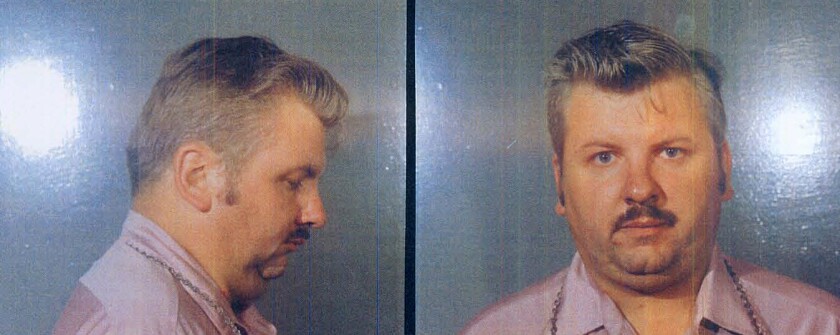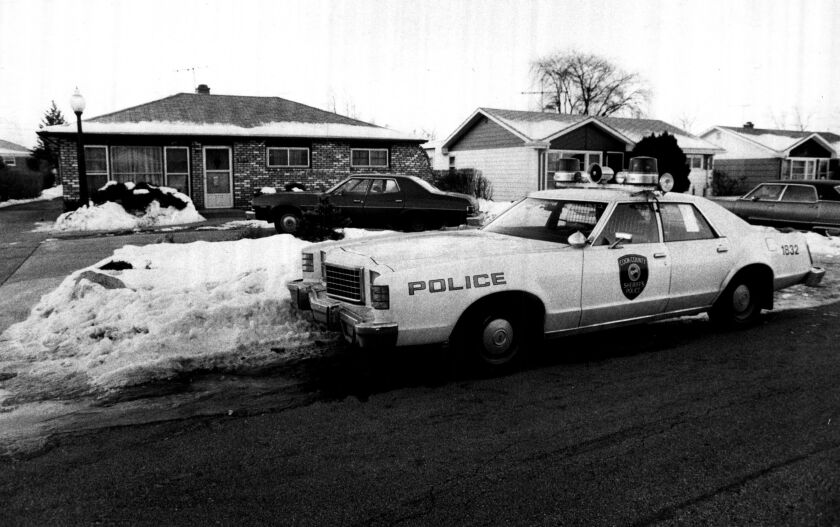John Wayne Gacy was dubbed the Killer Clown, and he looked like a Stephen King nightmare come to life in those creepy photos of him in full Pogo makeup — but most of the time, even after he confessed to raping and killing dozens of victims and was convicted and sentenced to death, Gacy looked and sounded so ordinary.
Like somebody’s blowhard uncle, the kind of guy who bragged a bit too much in a pathetic attempt to make himself seem like an important guy with impressive connections.
This is the Gacy we see at the outset of the six-part, six-hour “John Wayne Gacy: Devil in Disguise,” a Peacock Original docuseries premiering Thursday on the streaming service.
The year is 1992. One of the most notorious serial killers in recorded history sits in the warden’s office at the downstate Menard Correctional Center, wearing a button-down, short-sleeved shirt, his gray hair slicked back, a silver watch on his wrist. (Why does he need a watch?) He is about to have an extensive conversation recorded on video with legendary FBI profiler Robert Ressler.
Asked why he’s speaking for the first time about his case, Gacy says, “In light of all that has been used against me in the media, they’ve created this fantasy monster image, and it’s been going on for the last 12 years, and I’ve never had no comment, and I had no need to talk to the media for the simple reason that they were looking for sensationalism, and they were looking for the monster. … The idea that I’m a homosexual thrill killer and all that garbage. They’ve painted this image of me like I strolled down the streets and stalked young boys and slaughtered them. Hell, if you could see my schedule, my work schedule, you know damn well that I was never out there.”
Yet somehow the bodies of 29 victims were found on Gacy’s property, and four more bodies were discovered nearby, and it’s possible there were more victims.
But there’s poor John Wayne Gacy, whining about news coverage painting him in an unfavorable light. More than a quarter-century after Gacy was executed, his ordinary, regular-guy, obscenely narcissistic bull---- is still infuriating.
And if we’re being honest, still of macabre interest.
• • •
I was 19 years old and living at home in the south suburbs in December 1978 when I saw the shocking footage on the local news of grim-faced law enforcement personnel carrying body bag after body bag from Gacy’s home in unincorporated Norwood Park Township near the far Northwest Side of Chicago.
We all would later learn the average age of Gacy’s victims was just 17.5 years old. The oldest was only 22. They had really just started living their lives.
Here we are more than 40 years later, and Gacy remains a figure of repulsion and fascination, with the Peacock series just the latest and perhaps most extensive look at the story. We’ve had countless books and documentaries, the 1992 miniseries “To Catch a Killer” starring Brian Dennehy as Gacy and even a cheap, 2010 indie-horror film called “8213: Gacy House,” 8213 W. Summerdale being the street address for Gacy’s house. (I’ll have a full review of the Peacock series in the coming week.)
In the 1990s, as Gacy remained in the news —when stories surfaced about the possibility of other victim or in the buildup to his execution in 1994 or when his name would come up because someone was buying his paintings or putting his image on a bubblegum card — I was writing news and culture columns for the Sun-Times. On more than a few occasions, I wrote about John Wayne Gacy. He was in the news, and I wrote about the news.
•••
In one of the most chilling experiences of my life, I was given the opportunity to examine evidence against Gacy, which remained stored in a musty room years after his trial.
The square-shaped, wooden entranceway to Gacy’s crawlspace.
Grisly photos of bodies and body parts.
Envelopes containing high school class rings.
Photos of Gacy’s bedroom, with a clown painting on the wall and a TV and a clock radio that had belonged to one of his victims.
A piece of rope Gacy used to strangle victims.
Jackets worn by the victims.
Their driver’s licenses.
Gacy’s appointment book for 1978-79.
And Gacy’s hand-drawn diagram of the crawlspace, showing where some of the bodies were buried.
It felt as if pure horror existed in that evidence room.
•••
In the late 1990s and early 2000s, Gacy’s so-called artwork became popular with certain collectors. A nightclub in Beverly Hills commissioned a show of his paintings, some priced as high as $20,000.
The curator of the show said, idiotically, “There’s a lot more to John Wayne Gacy than 33 murders.”
Johnny Depp bought a “Pogo the Clown” painting but got rid of it when he learned the fee wasn’t going to charity, as he had been told.
I talked to a 28-year-old man who was selling a Gacy sketch of Ted Bundy on eBay. “I made a mistake buying this,” he said.
Not sure selling it was any less of a mistake. Burning it sounded like a better idea.
•••
For a decade after the Gacy house was gutted and eventually torn down, the lot remained vacant, collecting weeds and broken booze bottles courtesy of the steady stream of tourists who would visit the site.
Eventually, a new home was put up, and the numbers on the address were changed. The new home was easily the biggest and most impressive dwelling on the block.
In 1991, I spoke with the elderly man who lived there with his grown daughter.
“The past is the past,” he said. “See those marks on the front lawn? Bunch of kids on motorcycles rode up, right on the lawn, making all kinds of noise. People come by all the time, but I don’t know what they want. This is just a house now.”
•••
In the early 1990s, I visited with Dolores Nieder at the Ravenswood home where her son Johnny Mowery grew up. Mowery, a 19-year-old college student, was the 13th of Gacy’s 33 victims to be identified. Dolores and I spoke just after WBBM-TV’s Walter Jacobson had aired a five-part interview with Gacy.
“To my great relief, I don’t think Walter is glorifying him one bit,” Nieder told me. “He’s showing Gacy for the mope and the loser he really is. He’s trying to claim he’s innocent, can you believe that?
“What a pathetic jellyfish … but [the interview] reminds me that all these years after Johnny is gone, this guy gets to watch color TV, to eat what he likes, to play with his computer, to paint his pictures of Elvis and Jesus and the clowns …
“Why should we have to know about Gacy’s little hobbies and habits? My son liked to fish and play pool. He was a good kid, a regular guy. I wish people would remember that. I wish people would remember the victims.
“I just ask people to keep one thing in mind: this man took 33 lives and destroyed the lives of hundreds of living victims. Thirty-three is such a big number! If you got 33 people together at work or had a party for 33 people, think of how large a gathering that would be. And then picture one man systematically killing that many people.
“That’s who John Wayne Gacy is.”









